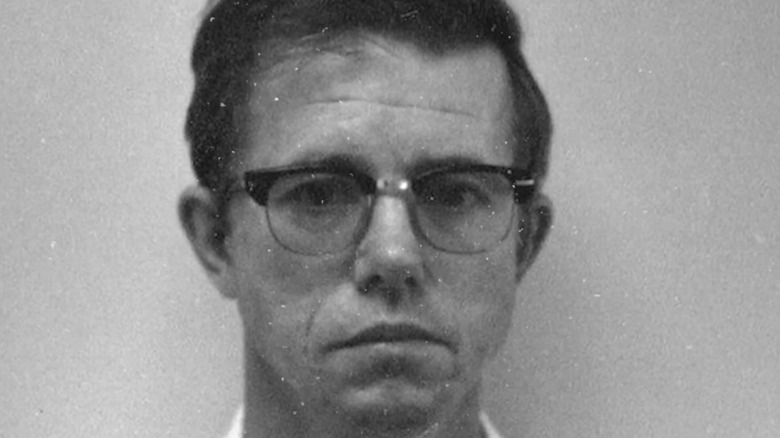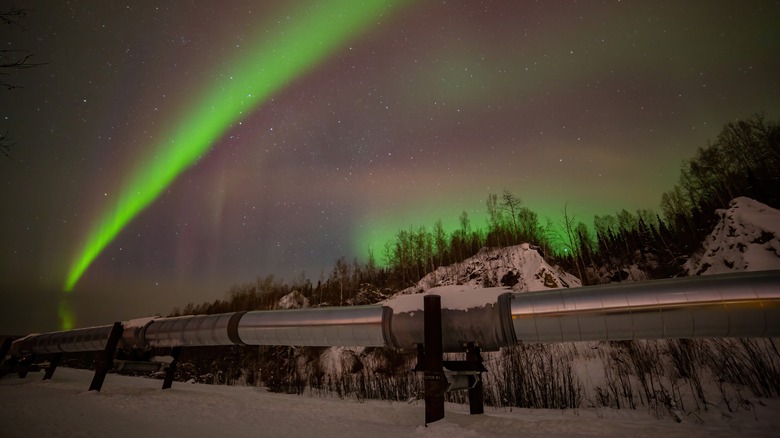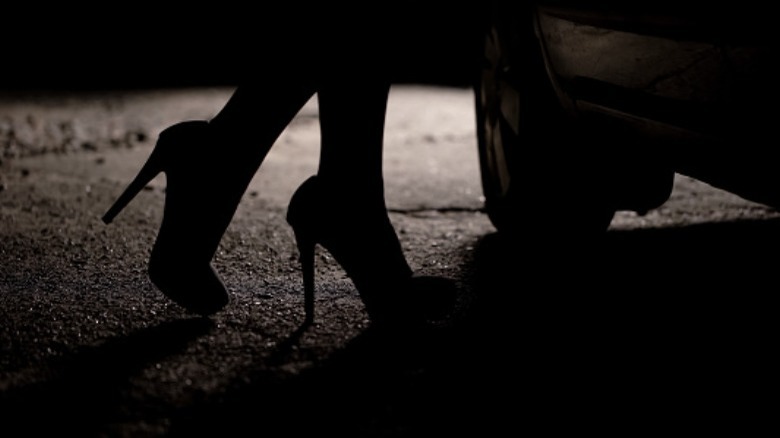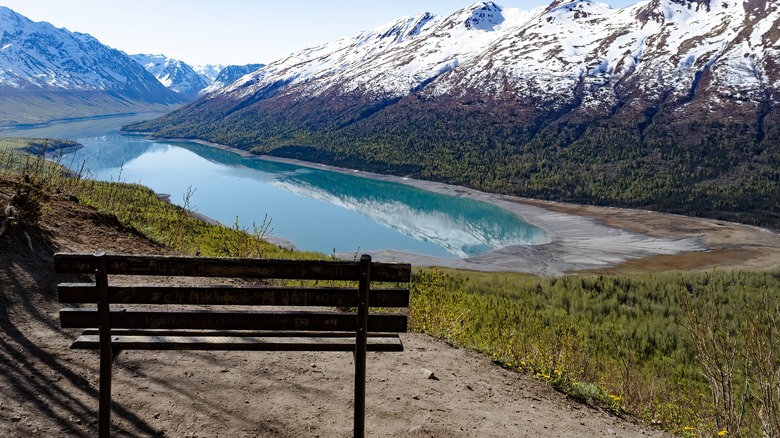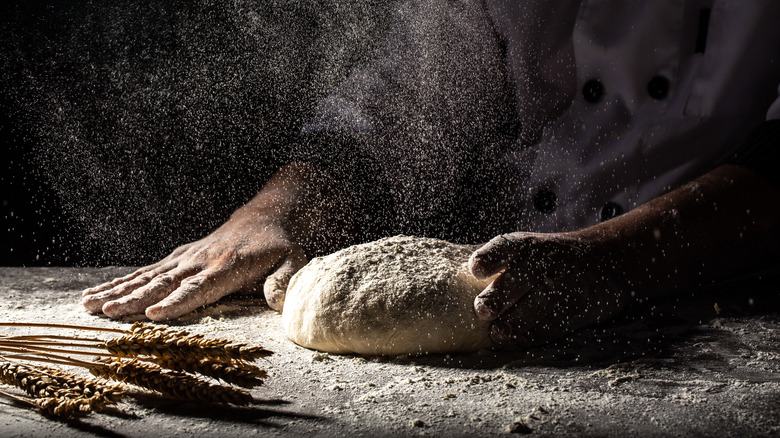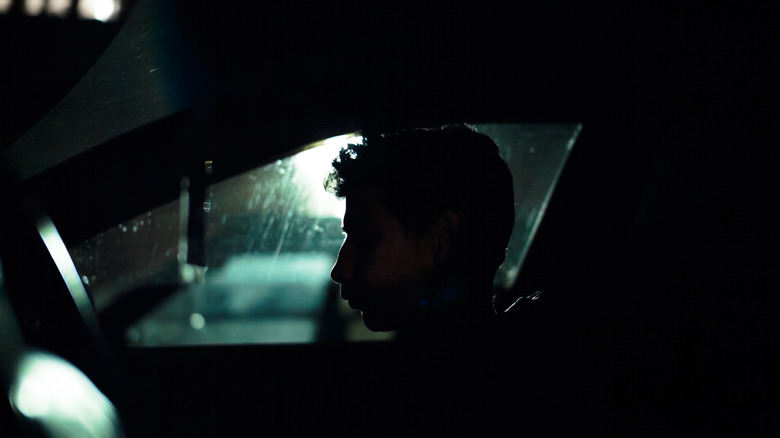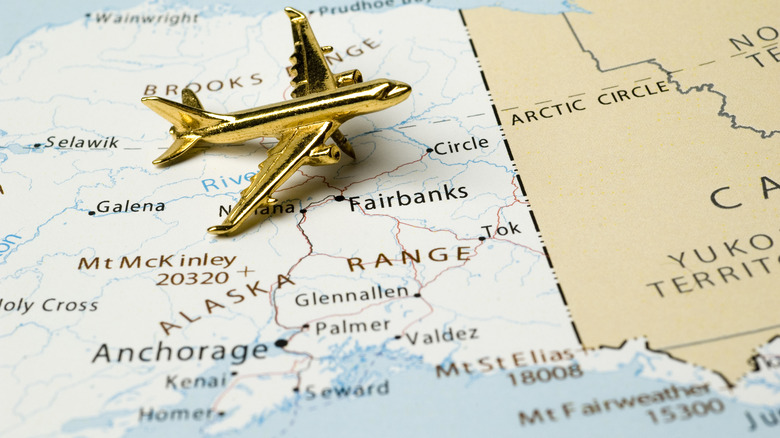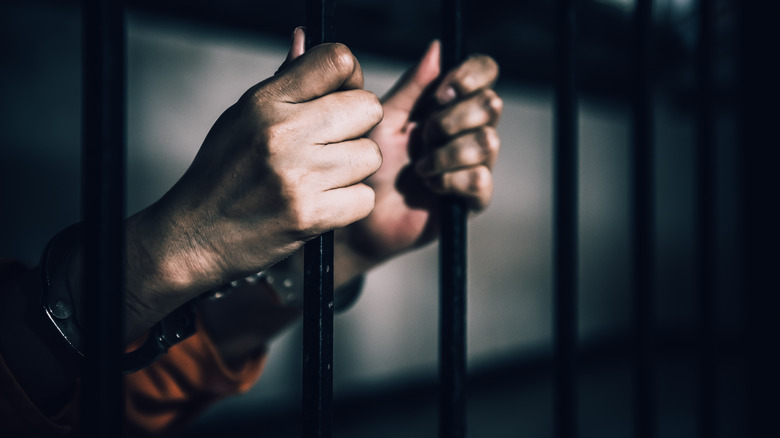Facts About Serial Killer Robert Hansen That Will Chill You To The Core
We may receive a commission on purchases made from links.
The 2013 movie "The Frozen Ground" stars Nicholas Cage in a very un-Nicolas-Cage like role as a sergeant with the Alaska State Troopers. He's chasing a serial killer who is (spoiler alert) played by John Cusak... in a very un-John-Cusak-like role. Investigators get a break in the case with evidence given to them by a 17-year-old girl, and it's the tale of a killer hunting his prey in the remote wilds of Alaska. If it sounds fictional, The Cinemaholic says that's how the film started out: Until that is, someone informed screenwriter Scott Walker that his version shared some eerie similarities to a very real case.
That was the story of a serial killer who really did hunt in the wildest reaches of Alaska, and who really did send his victims out into the woods to hunt them like the prey he viewed them as. By the time he was finally caught, Robert Hansen had been killing for a long time: He confessed to 17 murders and another 30 instances of rape.
Many serial killers get handed a nickname by the mainstream media, and Hansen was no different. Known as the Butcher Baker, his criminal tendencies that leaned more toward arson and theft took a sharp turn into murder by the 1970s. Even more terrifying than his modus operandi, his connection with crimes of all kinds, or even his trail of victims is that he was caught and arrested numerous times... before being released to kill again.
The murders were eerie, terrible, and premeditated
Robert Hansen doesn't have the same kind of name recognition that someone like Ted Bundy does, so let's talk about exactly what it is that he did. According to The Washington Post, Hansen found his run as one of the country's most prolific serial killers at an end in 1984: That's when he was convicted following his confession to killing 17 women over the course of 12 years.
Hansen kicked off his killing spree in the 1970s, and he found the perfect backdrop to both hunt and disappear. In 1974, the state got a much-needed economic boost with the kickoff of the construction of the Trans-Alaska Pipeline, which ran 800 miles from the North Slope to Valdez (via HistoryLink). It attracted people from all walks of life, including not only construction workers, but sex workers as well. Take a transient lifestyle, the tendency for people to look the other way when it comes to sex work, and thousands of square miles of nothing but barely patrolled wilderness, and it was a serial killer's paradise.
Hansen said as much during his confession, telling authorities that dancers, strippers, and sex workers were his favorite targets. After abducting them, he would either rape them and release them with a warning, or fly them — in his personal, private plane — out into the wilderness, where he would hunt them for sport. When they disappeared, it was assumed the women had simply skipped town.
If you or anyone you know has been a victim of sexual assault, help is available. Visit the Rape, Abuse & Incest National Network website or contact RAINN's National Helpline at 1-800-656-HOPE (4673).
Robert Hansen's difficulties began in childhood
In hindsight, serial killers often have traits in common and show signs of their adult inclinations as children. According to the University of the Free State's "A Psychobiography of Robert Hansen: The 'Butcher Baker,'" Hansen was no different. Born in 1939 to a father who forced him to work long hours at the family bakery — while subjecting him to ridicule and mockery — and a mother who was compliant in the harsh treatment of her son, Hansen grew up learning a lesson from his parents that would shape his later beliefs: Men were in charge, and women were weak.
By the time he was a teenager, he had grown into a socially awkward and shy young man who continued to be mercilessly mocked — this time, it came from his peers, and it was for his stutter and his appearance. Hansen was ultimately prosecuted by a man named Frank Rothschild, and years later, Rothschild would recall (to Fox News) how the bullying Hansen suffered as a child shaped his hatred of women. "The people who particularly made fun of him, that really, really got to him, were young girls. And so, the attitude he developed about the female sex came out of those times. ... this rage that was developed in adulthood came from those childhood experiences." The hatred lingered, too, even through his graduation and brief service in the army. When he left the military and returned home, he decided it was payback time.
Criminal tendencies manifested early on
The University of the Free State's "A Psychobiography of Robert Hansen: The 'Butcher Baker'" says that Robert Hansen's first experience with a sex worker came when he was in the military, and it was there that he discovered he relished in exerting control over the women he was with. Control, they say, became a dominant theme in his life, and his military experiences gave him the courage to burn down the bus garage at his former school in retaliation for the indignities he had suffered there.
That incident got him sentenced to three years in a state reformatory, and when he was released, he added more and more crimes to his record. Even as he continued to work at his parent's bakery, he also got in pretty consistent trouble for shoplifting. His chances were running out, and it was at that time that he decided to take his new wife and head to the remote wilds of Alaska.
It was there that he made his first kidnapping attempt, and it didn't go as he planned. Susie Heppeard escaped and reported the attack. Shockingly, Hansen was ordered to undergo court-appointed therapy and attacked and raped another woman slightly more than a month later. He briefly held Barbara Fields captive, and when he released her, she too went to authorities on the heels of a grisly discovery: A body had been discovered in the same area Hansen had taken her to. Again, Hansen was recommended for therapy.
If you or anyone you know has been a victim of sexual assault, help is available. Visit the Rape, Abuse & Incest National Network website or contact RAINN's National Helpline at 1-800-656-HOPE (4673).
Why did he start killing?
Robert Hansen gradually moved to the streets of Anchorage, which is where a profile from the University of the Free State says he went to look for a certain type of person: In his mind, he had labeled them "bad girls." When he picked someone up, one of two things would happen: If they were compliant, did what he told them to, and played into his domination fantasy, he would rape them and let them go. Anyone who fought back would be dragged onto his plane, taken to the remote wilderness, released, and then hunted in a game of hunter-and-prey that would end with their deaths.
The Anchorage Daily News says that after his arrest in connection with the murders, he explained that his first victim had been almost accidental. He killed her when she tried to escape, and it was part of a motive that would play out over and over again for Hansen and his victims.
When The New York Times reported on the court proceedings of his trial and sentencing, they quoted an explanation from the District Attorney, Victor Krumm. He explained Hansen's view of women and his hunting motives, saying that his trigger was rejection. "He nevertheless liked and respected women who he felt, in his mind, were good." But those who became his victims? "He considered them inferior, so it was all right [to kill them]."
If you or anyone you know has been a victim of sexual assault, help is available. Visit the Rape, Abuse & Incest National Network website or contact RAINN's National Helpline at 1-800-656-HOPE (4673).
His first victim was never identified
Robert Hansen's first victim remains unidentified, and according to the National Center for Missing & Exploited Children, her remains were discovered on July 17, 1980, just outside the town of Eklutna. They call her Jane Doe, but because of the location of her remains, she was nicknamed Eklutna Annie by law enforcement. Because she had been killed at least a year prior to the discovery of her remains, some of the details are estimated: Her age was put between 16 and 25, her height at around 5 feet, and she was believed to have some Native American ancestry.
Hansen recounted the murder to law enforcement after his arrest in connection with other killings, saying that he had picked her up on the street and just assumed she was a sex worker. On the way to Muldoon, he said he had promised her that if she complied, he wouldn't hurt her. However, when his truck became mired in mud she took the opportunity to try to escape, even though he had been holding her at gunpoint.
According to the Anchorage Daily News, Hansen said that she had been armed, too — "she'd had a knife in her purse." It was her knife that he grabbed and stabbed her with, then dumped her where she was found later by workers repairing area electrical lines. Hansen claimed that he had never known her real name, and she is still unidentified.
He appeared to live a normal life
Leland Hale is the co-author of "Butcher, Baker: The True Account of an Alaskan Serial Killer." He wrote not only about Hansen's crimes, but also about how he was married twice, and how his second wife — Darla Marie Henrichsen Hansen — stayed with him even though she knew something was terribly, terribly wrong.
Hale says (via his blog) that he had interviewed her after Hansen's convictions, and she confirmed that yes, she had always known that her husband was doing something he shouldn't have been... but that she had never thought it was murder. Her suspicions ended with Hansen hiring sex workers, and Hale says that the devoutly religious Darla believed that she could help him find his way back to God. At the same time, she also shared how they kept their lives surprisingly separate for a married couple: She raised the children, spent summers in Arkansas with her family, and tutored children with learning disabilities, while he ran the family bakery.
Darla finally left him after his murder conviction, but according to prosecutor Frank Rothschild, she wasn't the only one that had shared a life with him without knowing the extent of his crimes. His employees, too, saw someone very different... albeit capable of great rage. "He was a small guy," Rothschild said (via Fox News). "He came across as a little mild-mannered sort of fellow. You didn't initially have any sense of what he was hiding behind the mask."
He had been arrested multiple times
Perhaps even more shocking than the crimes of the so-called Butcher Baker is the number of times he was arrested for other adjacent crimes. In addition to serving time in a state reformatory for arson (via the University of the Free State), The New York Times reported that he had been arrested three separate times over the course of 12 years, and each time the charges involved kidnapping, rape, and violence against women.
In spite of his record and the fact that he was known to law enforcement, Hansen served only brief jail sentences and was often sentenced to court-ordered therapy. Dating back to his post-military time at the reformatory, he revealed his desires to the psychiatrists assigned to his case, reportedly sharing his fantasies of acting out violent revenge against those who had wronged him and — in particular — women who mocked, laughed at, rejected, and disobeyed him.
After an early conviction on charges of kidnapping and raping an 18-year-old, he was sentenced to a work release program. On his first night of freedom from the program, he headed into Anchorage, watched the sex workers plying their trade, and hatched the plan to hunt them in the same way he hunted the animals that prowled the wilderness around him.
If you or anyone you know has been a victim of sexual assault, help is available. Visit the Rape, Abuse & Incest National Network website or contact RAINN's National Helpline at 1-800-656-HOPE (4673).
One brave survivor helped secure his final conviction
On September 27, 1983, 18-year-old Cindy Paulson sat down with Alaska State Trooper Sgt. Glenn Flothe, and gave a full statement regarding the night she had been attacked (via Leland Hale). It started when Robert Hansen approached her and offered her $200 to perform a sex act, and when they were in his car, Paulson said he pulled a gun on her and handcuffed her.
Paulson went on to say that he had taken her back to his home, assaulted her again, and told her that he was going to take her to his cabin. They drove to the airport where his plane was, and Paulson said that seeing an opportunity, she ran. She didn't get far when a truck driver pulled over and picked her up, and initially, she had no intention of pursuing the matter. He dropped her off at the hotel she requested, but according to The Cinemaholic, he then reported the incident to the police.
Law enforcement convinced her to show them the plane, which gave them the grounds to go after Hansen with search warrants that helped them compile enough evidence for a trial and a conviction. Paulson's whereabouts were unknown as of January 2023, but she did contribute to the 2013 movie "The Frozen Ground" based on the crimes (where she was played by Vanessa Hudgens). At the time, she was living with her family and later thanked director Scott Walker for helping her find closure.
If you or anyone you know has been a victim of sexual assault, help is available. Visit the Rape, Abuse & Incest National Network website or contact RAINN's National Helpline at 1-800-656-HOPE (4673).
Considerable evidence helped put Robert Hansen behind bars
Once law enforcement interviewed Robert Hansen (who claimed to never have met the woman who went to Alaska State Troopers to tell of her kidnapping and assault), Oxygen says they kept digging — and after his alibi fell apart, the search warrant and following investigation into Hansen's home turned up some convincing evidence. Along with a soundproof room hidden behind a basement wall panel, they also recovered jewelry — trophies taken from the victims — and weapons.
The biggest piece of evidence was a flight map, marked with a series of circles illustrating the burial locations of victims.
According to Leland Hale, author of "Butcher, Baker: The True Account of an Alaskan Serial Killer," (via his blog), Hansen admitted to the murders of 17 women, most of whom were buried in the wilderness to the northeast of Anchorage. (He denied responsibility for any burials found at some of the markings.) Hale says that each of the locations has been investigated, although not all the remains have been recovered: The map was meant to show a general location, and the Alaskan wilderness is vast.
If you or anyone you know has been a victim of sexual assault, help is available. Visit the Rape, Abuse & Incest National Network website or contact RAINN's National Helpline at 1-800-656-HOPE (4673).
Robert Hansen was finally convicted in 1984
According to The Washington Post, Robert Hansen ultimately confessed to the murder of 17 women, and to 30 more counts of rape. Instead of going on trial for each one of the 17 murders individually, he was convicted on four counts of murder. (They also note that the remains of five of his victims were never recovered, while 12 were.) With the guilty verdict, Hansen was handed a lengthy 461-year prison sentence.
He only served 30 years of it. The Anchorage Daily News reports that he died in 2014, with initial reports saying that he had died of natural causes after around a year of declining health. Glenn Flothe, the state trooper who had spearheaded his capture and conviction, responded to the news of his death with this statement: "On this day, we should only remember his many victims and all of their families, and my heart goes out to all of them. As far as Hansen is concerned, this world is better without him."
It was also noted, though, that with his death came a lack of closure. Although he had been connected to 17 murders, law enforcement had long suspected that there were other victims that hadn't been recovered or identified — and that knowledge went to the grave with the so-called Butcher Baker.
One victim was identified in 2021
There's a footnote in the sordid story of Robert Hansen, the serial killer that came to be known as the Butcher Baker. Thankfully, it's one of closure.
In 2021, The Seattle Times reported that one of Hansen's victims had been identified with the help of DNA and a genealogy match. Of the 12 victims recovered during Hansen's confession and trial, 10 had been identified. One — his first kill, known as Eklutna Annie — remains unknown, but the 11th victim, once only known as Horseshoe Harriet, has now been named Robin Pelkey.
Her remains had been dumped on the ground near Horseshoe Lake (pictured) and were recovered in 1984. There was no identification and Hansen told law enforcement that he hadn't bothered to get her name, only that he had picked her up off the streets of Anchorage, forced her onto his plane, and flew out to the lake, where he killed and dumped her. Her case went cold and was reopened in 2014 in the hopes that a DNA match could be made. Pelkey, a Colorado native who moved to Alaska with her father and stepmother, ended up on the streets not long after. She was 19 years old when she was killed. Her parents died before the identification of her body, and she was never reported as missing. Her grave marker was purchased by Alaska State Troopers.
